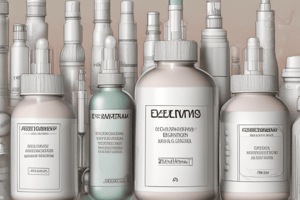Podcast
Questions and Answers
What type of disperse system is a pharmaceutical emulsion?
What type of disperse system is a pharmaceutical emulsion?
- Homogeneous system
- Heterogeneous system (correct)
- Saturated system
- Colloidal system
Which phase is finely divided and distributed throughout the other phase in a pharmaceutical emulsion?
Which phase is finely divided and distributed throughout the other phase in a pharmaceutical emulsion?
- Dispersed phase (correct)
- Primary phase
- Continuous phase
- Secondary phase
Which type of emulsion has an oily continuous phase?
Which type of emulsion has an oily continuous phase?
- Oil in water (o/w)
- Oil in oil
- Water in water
- Water in oil (w/o) (correct)
What is the role of an emulsifying agent in a pharmaceutical emulsion?
What is the role of an emulsifying agent in a pharmaceutical emulsion?
What type of dosage forms are almost o/w type emulsions convenient for administering?
What type of dosage forms are almost o/w type emulsions convenient for administering?
Which hydrophilic colloid is commonly used in extemporaneously prepared internal emulsions?
Which hydrophilic colloid is commonly used in extemporaneously prepared internal emulsions?
What is the compounding technique called where acacia is triturated with water before adding oil in small amounts?
What is the compounding technique called where acacia is triturated with water before adding oil in small amounts?
What is the primary color of print used for labeling in the described pharmaceutical preparation?
What is the primary color of print used for labeling in the described pharmaceutical preparation?
Which mechanism describes the phenomenon where emulsion droplets merge to form larger droplets?
Which mechanism describes the phenomenon where emulsion droplets merge to form larger droplets?
What could cause the breaking of an emulsion due to droplets merging to form even larger droplets?
What could cause the breaking of an emulsion due to droplets merging to form even larger droplets?
Which technique involves adding volatile oils and low-viscosity oils in a bottle method?
Which technique involves adding volatile oils and low-viscosity oils in a bottle method?
What would be an appropriate auxiliary label for a pharmaceutical emulsion to prevent excessive usage?
What would be an appropriate auxiliary label for a pharmaceutical emulsion to prevent excessive usage?
What is the main role of liquid paraffin in the pharmaceutical preparation described in the text?
What is the main role of liquid paraffin in the pharmaceutical preparation described in the text?
In the compounding method described, what is the purpose of using the dry gum method?
In the compounding method described, what is the purpose of using the dry gum method?
Which component is responsible for giving the emulsion its sweet taste?
Which component is responsible for giving the emulsion its sweet taste?
What is the primary purpose of adding benzoic acid and chloroform to the preparation?
What is the primary purpose of adding benzoic acid and chloroform to the preparation?
Why is it essential not to over mix when adding acacia to the paraffin oil?
Why is it essential not to over mix when adding acacia to the paraffin oil?
What could be the consequence of not using a dry mortar and pestle during the compounding process?
What could be the consequence of not using a dry mortar and pestle during the compounding process?
Flashcards are hidden until you start studying
Study Notes
Pharmaceutical Emulsions
- A pharmaceutical emulsion is a type of disperse system consisting of two immiscible liquids, where one liquid (the dispersed phase) is finely divided and distributed throughout the other (the continuous phase).
- Emulsions can be prepared for oral, external, parenteral, and ophthalmic use as liquids or semisolids.
Types of Emulsions
- Oil in water (o/w) emulsions: the continuous phase is aqueous.
- Water in oil (w/o) emulsions: the continuous phase is oily.
Factors Affecting Emulsion Type
- Relative proportions of the two present phases.
- Type of selected emulsifying agent.
Oral Dosage Forms
- Emulsions as oral dosage forms are almost o/w type.
- Convenient means of administering unpleasant oily solution drugs.
Preparing Acacia Emulsions
- Use acacia gum (hydrophilic colloid) as an emulsifying agent.
- Make a thick primary emulsion first using pestle and mortar.
- Wet gum method (English method) and Forbes bottle method are two compounding techniques.
Labeling and Storage
- Labels: "Keep out of reach of children", "For oral use", "Shake well before use", & "Avoid excessive use".
- Shelf life: one month.
- Storage conditions: "store in cool and dry place, avoid freezing".
Instability Mechanisms
- Creaming: emulsion separates due to density difference, where oil droplets rise to the surface.
- Flocculation: droplets come together to form larger droplets.
- Coalescence: droplets merge to form even larger droplets.
- Freezing can cause coalescence, leading to breaking of the emulsion.
- Heating can lead to creaming, which is reversible by shaking.
Active Pharmaceutical Ingredients and Additives
- Liquid paraffin: active pharmaceutical ingredient, used as a laxative.
- Sodium saccharine: non-caloric sweetening agent.
- Vanillin: flavoring agent.
- Chloroform (single strength) and benzoic acid (aqueous solution): preservatives.
- Acacia: emulsifying agent.
Compounding Method
- Dry gum method (continental method): measure required volume of paraffin oil, weigh acacia, and mix lightly using a dry pestle to disperse lumps.
- Gradually dilute the primary emulsion with small volumes of water, ensuring complete mixing between additions.
Studying That Suits You
Use AI to generate personalized quizzes and flashcards to suit your learning preferences.




